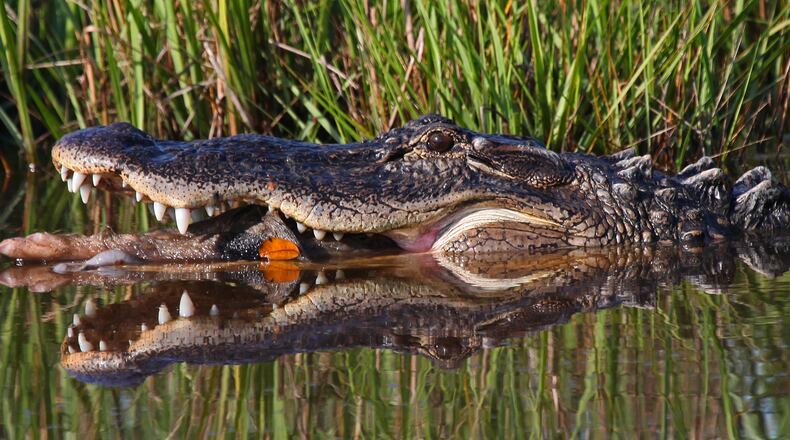Ossabaw Island isn’t the easiest place to visit.
The 25,000-acre Georgia barrier island is about 20 minutes by boat from Savannah. Your own boat that is (unless you charter one or snag a spot on one of the day trips sponsored by the nonprofit Ossabaw Island Foundation).
Once there, you might run into alligators, wild hogs, maybe even a donkey.
Luckily, "Ossabaw Island: A Sense of Place" (Mercer University Press, $45) offers the next best thing to visiting the largely uninhabited, yet undeniably wondrous island. Featuring over 100 stunning photos by Jill Stuckey and a lyrical, informative text by Georgia Southwestern State University history professor Evan Kutzler, the new book makes readers feel like intimate inhabitants of the one-of-a-kind island's past and present.
"It was a story that should be told," said Stuckey, who'll be at the Jimmy Carter Presidential Library on March 23 along with Kutzler and Roger Parker, whose over half a century working on and caring for Ossabaw has earned him the nickname "Saltwater Cowboy ." "It's an amazing story."
In part it's the story of what one woman did to preserve and protect Ossabaw, described in this earlier AJC story as "an island paradise, if you like your islands wild, timeless and bereft of commercial influence." That includes the deal Eleanor "Sandy" West made with then Georgia Gov. Jimmy Carter to sell the privately owned island to the state in 1978.
West’s parents had purchased Ossabaw in 1924, and even decades after Carter signed an executive order that made it Georgia’s first Heritage Preserve, she continued to live in the 20,000 Spanish colonial revival Main House (the deal allowed her to stay there until her death, upon which the foundation will take control of the mansion).
“Ossabaw is what it is today because Sandy fought to preserve it, enlisted the support of others, and in the end, made compromises that put the future of the island ahead of self-interest,” Carter writes in the book’s foreword about the now 104-year-old West, who finally moved to an assisted living facility in Savannah last May.
RELATED VIDEO: Discover Georgia’s Barrier Islands
But Ossabaw’s story is also one of nature’s awesome power: To alternately enthrall and unnerve, to evolve -- but most of all, to perservere.
“When (West) passes away, when the (state Department of Natural Resources) possibly removes the last donkeys and hogs from the island, and when the island reclaims the ruins of buildings not slated for preservation,” Kutzler writes at the end of the book, “The island will begin to construct yet another layer of its long history.”
Stuckey first started going to Ossabaw in 1993 as a state Environmental Protection Department employee; in 2008, following her husband’s unexpected death, she found “solace and strength” while spending increased amounts of time there.
Invariably she brought along a camera. Over the years, she took so many compelling photos -- of salt marshes and maritime forests, “tabby” slave cottages and the sprawling Main House dining room, coiled rattlesnakes and posing-on-one-leg storks -- that it took an expanded village of sorts to help narrow them down to a manageable number for the book.
"I have a photo (album) where I put the ones I like and everyone who comes to my house, I'm asking, 'What do you like best?'" chuckled Stuckey, who lives in Plains, where's she's a member of the city council and a close friend of Jimmy and Rosalynn Carter. "I've literally done that with hundred of people over the years. And then I chose some I loved and coaxed others into loving!"
The book includes some “high dynamic range” photos, a technique that results in an image that feels caught somewhere between reality and a dreamscape. It also draws on the invaluable insights of Parker, who accidentally spent the night alone on Ossabaw when he went there to deliver cattle as a 16-year-old in 1951 and arguably never really left.
“Through all these changes in the land,” Kutzler writes by way of introducing him, “Roger has been the constant.”
Copies of the book will be available for purchase at the Carter Library event, with a portion of the proceeds going to the Ossabaw Island Foundation. The book is also sold on the foundation's web site at www.ossabawisland.net.
MEET THE AUTHORS
"Ossabaw Island: A Sense of Place" lecture and book-signing. 7 p.m. March 23. Free. Jimmy Carter Presidential Library & Museum Theater. 441 Freedom Parkway, Atlanta. 404-865-7100. www.jimmycarterlibrary.gov.
About the Author
The Latest
Featured




